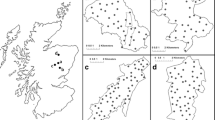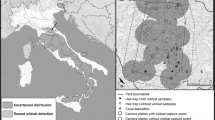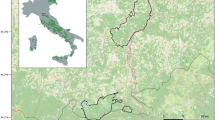Abstract
Genetic methods are increasingly being used as noninvasive tools to survey populations of wild animals. One challenge of these methods is the sampling of genetic material from the target species. Genetic material of various predators, such as bears, canids, and felids, has been successfully obtained from both hair trapped in snares and scat. However, there is currently no standard procedure for sampling genetic material from the Eurasian Lynx (Lynx lynx). We tested established and newly developed hair snares in two near-natural lynx enclosures in the Bavarian Forest National Park. All snares consisted of a wooden post; they differed in the type of material attached to the post for snaring hair: carpet (velour with 40 nails), wildcat (spruce wood with 2–3 mm deep, horizontal and diagonal ridges), wire brush, doormat, or rubber bands (250 g of rubber bands wrapped around the post). We determined the acceptance of the hair snares by the animals by observing their behavior with the aid of video cameras. The number of rubbing events on the different trap types did not significantly differ, but the rubbing duration was longer for the doormat hair snare. The wire brush hair snare collected the highest total amount of hair and — beside the carpet — the highest amount of hair per unit of time. Almost all hair trapped on the wire brush snare were retained during a 2-week exposure to the elements outside of the enclosures. The results of our study may hold for other felid species with hair characteristics similar to those of lynx.


Similar content being viewed by others

References
Belant JL (2003) A hairsnare for forest carnivores. Wildl Soc Bull 31(2):482–485
Bonaker P (2008) Field method efficacy to detect medium and large mammal presence near roadways at Vail Pass, Master thesis. University of Montana, Colorado, p 47
Boulanger J, Kendall KC, Stetz JB, Roon DA, Waits LP, Paetkau D (2008) Multiple data sources improve DNA-based mark-recapture population estimates of grizzly bears. Ecol Appl 18:577–589
Bremner-Harrison S, Harrison S, Cypher BL, Murdoch JD, Maldonado J, Darden SK (2006) Development of a single-sampling noninvasive hair snare. Wildl Soc Bull 34(2):123–461
Cutler TL, Swann DE (1999) Using remote photography in wildlife ecology: a review. Wildl Soc B 27:571–581
Downey PJ, Hellgren EC, Caso A, Carvajal S, Frangioso K (2007) Hair snares for noninvasive sampling of felids in North America: do gray fox affect success? J Wildl Manage 71(6):2090–2094
Ehlert K (2005) Chronoetologie und Enviromental Enrichment in der Tiergartenbiologie und die Anwendung in der Haltung des Sibirischen Luchses (Lynx lynx wrangeli). Diplomarbeit Johann Wolfgang Goethe-Universität, Frankfurt am Main
Elston DA, Moss R, Boulinier T, Arrowsmith C, Lambin X (2001) Analysis of aggregation, a worked example: numbers of ticks on red grouse chicks. Parasitology 122:563–569
Gardner B, Royle JA, Wegan MT, Raiboltd RE, Curtise PD (2010) Estimating black bear density using DNA from hair snares. J Wildl Manage 74(2):318–325
Goossens B, Waits LP, Taberlet P (1998) Plucked hair samples as a source of DNA: reliability of dinucleotide microsatellite genotyping. Mol Ecol 7:1237–1241
Harrison RL (2006) A comparison of survey methods for detecting bobcats. Wildl Soc Bull 34(2):548–552
Hayward GD, Miquelle D, Smirnov EN, Nations C (2002) Monitoring Amur tiger populations: characteristics of track surveys in snow. Wildl Soc Bull 30(4):1150–1159
Hothorn T, Bretz F, Westfall P (2008) Multcomp: simultaneous inference for general linear hypotheses. R Package Version 1.0-3. http://CRAN.R-project.org
Hupe K, Simon O (2007) Die Lockstockmethode – eine nicht invasive Methode zum Nachweis der Europäischen Wildkatze (Felis silvestris silvestris). Informationsdienst Naturschutz Niedersachsachsen 27(1):66–69
Jedrzejewski W, Jedrzejewska B, Okarma H, Schmidt K, Bunevich AN, Milkowski L (1996) Population Dynamics (1869–1994), demography, and home ranges of the lynx in Bialowieza primeval forest (Poland and Belarus). Ecography 19:122–138
Kendall KC, McKelvey K (2008) Hair collection. In: Long AR, Mac Kay P, Zielinski WJ, Ray JC (eds) Noninvasive survey methods for carnivores. Island Press, Washington, pp 141–182
Laass J (2001) Zustand der Luchspopulation im westlichen Berner Oberland im Winter 2000, Fotofallen-Einsatz Nov./Dez. 2000; KORA Bericht Nr. 6 d
Linnell JDC, Swenson JE, Landa A, Kvam T (1989) Methods for monitoring European large carnivores. A worldwide review of relevant experience. Nina Oppdragsmelding 549:1–38
Linnell JDC, Fiske P, Herfindal I, Odden J, Broseth H, Anderson R (2007a) An evaluation of structured snow-track surveys to monitor Eurasian lynx Lynx lynx populations. Wildl Biol 13:456–466
Linnell JDC, Odden J, Andrén H, Liberg O, Andersen R, Moa P, Kvam T, Broseth H, Segerström P, Ahlqvist P, Schmidt K, Jedrzejewski OH (2007b) Distance rules for minimum counts of Eurasian lynx Lynx lynx family groups under different ecological conditions. Wildl Biol 13:447–455
Linnell J, Salvatori V, Boitani L (2008) Guidelines for population level management plans for large carnivores. A Large Carnivore Initiative for Europe report prepared for the European Commission
Long RA, Donavan TM, Mackay P, Zielinski WJ, Buzas JS (2007) Comparing scat detection dogs, cameras, and hair snares for surveying carnivores. J Wild Manage 71(6):2018–2025
Luedicke T (2004) Chronoetologie und Enviromental Enrichment in der Tiergartenbiologie und die Anwendung in der Haltung des karpatischen Luchses (Lynx lynx carpathicus). Diplomarbeit Johann Wolfgang Goethe-Universität, Frankfurt am Main
Luikart G, Cornuet JM (1998) Empirical evaluation of a test for identifying recently bottlenecked populations from allele frequency data. Conserv Biol 12(1):228–237
McDaniel GW, McKelvey KS, Squires JR, Ruggiero LF (2000) Efficacy of lures and hair snares to detect lynx. Wildl Soc Bull 28(1):119–123
McKelvey KS, von Kienast J, Aubry KB, Koehler GM, Maletzke BT, Squires JR, Lindquist EL, Loch S, Schwartz MK (2006) DNA-analysis of hair and scat collected along snow tracks to document the presence of Canada lynx. Wildl Soc Bull 34(2):451–455
Mestemacher U, Lampe T, Huckschlag D, Anders O, Rühe F (2007) Die Eignung verschiedener Duftstoffe zum Einsatz an Haarfallen – ein Gehegeversuch mit Eurasischen Luchsen (Lynx lynx L. 1758). Beiträge zur Jagd- und Wildtierforschung Bd 32:423–435
Mills LS, Pilgrim KL, Schwartz MK, McKelvey K (2000) Identifying lynx and other North American felids based on MtDNA analysis. Conserv Genet 1:285–288
O'Connell AF, Nichols JD, Karanth KU (2011) Camera traps in animal ecology. Methods and analyses. Springer, Tokyo
Proctor M, McLellan BN, Strobeck C, Barclay MR (2005) Genetic analysis reveals demographic fragmentation of grizzly bears yielding vulnerably small populations. Proc R Soc Lond Ser B Biol Sci 272:2409–2416
Ritland K (1996) Estimators for pairwise relatedness and individual inbreeding coefficients. Genet Res 67:175–185
Ruell EW, Crooks KR (2007) Evaluation of noninvasive genetic sampling methods for felid and canid populations. J Wildl Manage 71(5):1690–1694
Sargeant GA, Johnson DH, Berg WB (2003) Sampling designs for carnivore scent-station surveys. J Wildl Manage 67(2):289–298
Schmidt K, Kowalczyk R (2006) Using scent-marking stations to collect hair samples to monitor European lynx populations. Wildl Soc Bull 34(2):462–466
Schwartz MK, Luikart G, Waples RS (2007) Genetic monitoring as a promising tool for conservation and management. Trends Ecol Evol 22:25–33
Sunquist M, Sunquist F (2002) Wild cats of the world. University of Chicago Press, Chicago
Turback G (1998) Seeking the missing lynx. Natl Wildl Mag 36(1):18–25
Venables WN, Ripley BD (2002) Modern applied statistics in S. Springer. Springer, Heidelberg
Weaver JL, Baxter B, Amato (1997) Lynx Survey and Habitat Assessment. Kootenai National Forest, Montana. Year 1 Progress Report. Wildlife Conservation Society, New York
Weaver JL, Wood P, Paetkau D (2003) A new non-invasive technique to survey ocelots. Wildlife Conservation Society Publication
Weaver JL, Wood P, Paetkau D, Laack LL (2005) Use of scented hair snares to detect ocelots. Wildl Soc Bull 33(4):1384–1391
Weber D, Ginter H-P, Hefti-Gautschi B (2008) Die Aktuelle Verbreitung der Wildkatze (Felis silvestris silvestris Schreber 1777) im Baselland und angrenzenden Gebieten. Tätigkeitsberichte der Naturforschenden Gesellschaft Baselland Band M11:177–185
Williams CL, Blejwas K, Johnston JJ, Jaeger MM (2003) A coyote in sheep’s clothing: predator identification from saliva. Wildl Soc Bull 31:1–7
Williams BW, Etter DR, Linden DW, Millenbah KF, Winterstein SR, Scribner KT (2009) Noninvasive hair sampling and genetic tagging of co-distributed fishers and American Martens. J Wildl Manage 73(1):26–34
Woods JG, Paetkau D, Lewis D, McLellan BN, Proctor M, Strobeck C (1999) Genetic tagging free ranging black and brown bears. Wildl Soc Bull 27(2):616–627
Acknowledgements
This study is part of a project on the predator–prey relationship of lynx, red deer, and roe deer carried out by the Bavarian Forest National Park Administration, Department of Research and Documentation. Financial support was provided by the EU-Programme Ziel 3 Freistaat Bayern—Tschechische Republik 2007–2013 (Interreg IV) and the Bavarian Forest National Park Administration. We kindly thank Horst Burghart, Martin Gahbauer, Reinhold Gaisbauer, Werner Kirchner, Andreas Hackl, Günter Meier, and Kathrin Mayer for technical support and valuable discussions. We also thank Karen A. Brune for language editing.
Author information
Authors and Affiliations
Corresponding author
Additional information
Communicated by C. Gortázar
Rights and permissions
About this article
Cite this article
Heurich, M., Müller, J. & Burg, M. Comparison of the effectivity of different snare types for collecting and retaining hair from Eurasian Lynx (Lynx lynx). Eur J Wildl Res 58, 579–587 (2012). https://doi.org/10.1007/s10344-011-0607-x
Received:
Revised:
Accepted:
Published:
Issue Date:
DOI: https://doi.org/10.1007/s10344-011-0607-x



